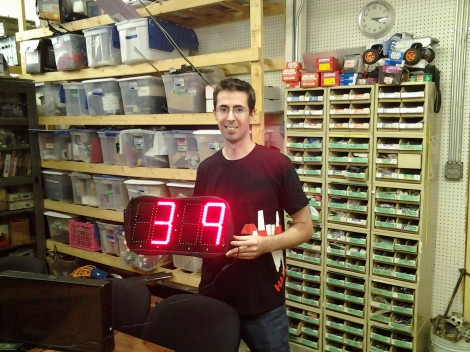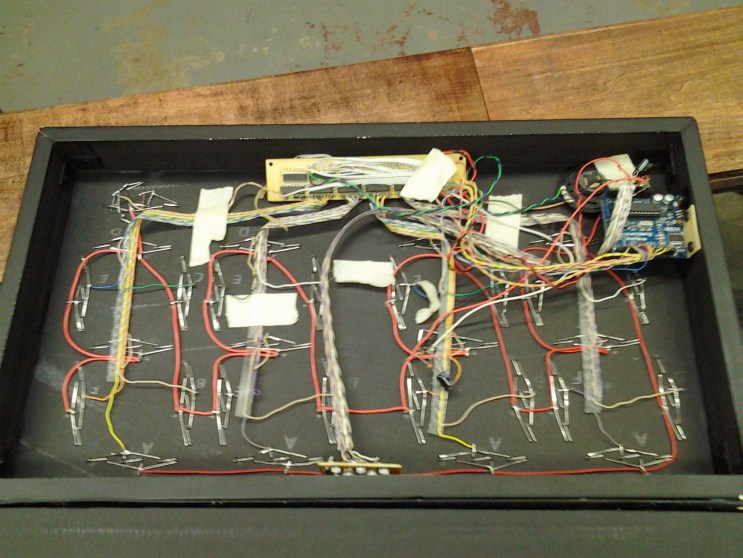
[Mike Szczys] recently got together with [Bob Baddeley] to talk about his experiences taking a hobby project to market. He’s not quite there yet, but [Bob] decided to travel a route which we find quite interesting. He has been taking part in a 111 day accelerator program called Haxlr8r. The idea is that this experience will give him the manufacturing chops he needs to meet the demand when his product actually launches. He spent a considerable amount of time in China, an experience he blogged about at length. The program also provides development cash in return for a percentage of the company.
The product he’s working on is an LED scoreboard, which explains why he calls the company Portable Scores. It started as a hobby project, and he brought one of the early prototypes along to show off in the video after the break. It’s a wooden frame, with foam board for the back and substrate, and clear acrylic on the front to protect the LEDs. All of the soldering is point-to point (there’s an image of this available after the break too). His redesigns have moved from Arduino to a PIC controller, made the entire face of the display one PCB, and added Bluetooth control. It’s great to see someone really go for it with a well-conceived project. We wish him all the best!
Wiring for the prototype display:
















Man, 200k to get this going huh?
This is such a great idea but I can’t help think Bob Baddeley’s project is a lot of hassle for a hardware implementation of the concept. A smartphone app would sell better and be a lot less hassle especially on the certification side.
This being said I would like to hear more about this. Particularly FCC and CE approval seems daunting and very very expensive. A cursory search will show that it costs somewhere around 20000USD for EACH project. That’s insane. It’s almost the entire budget I can dedicate to bring a project to market myself.
Where does it say it costs 20,000 USD to do FCC certification?
From my experience, all you need at the bare minimum is a half day of testing at a test site, which can cost as little as 1,100 USD.
I am less familiar with CE, but I’m pretty sure you can get a device certified for much less than 20K USD.
With CE your biggest cost can be acquiring texts of the norms you need to be compliant with. Since CE means that manufacturer (or importer) promises you that given product complies with every norm that applies (under normal operation) you have to find out which ones apply (if any). And those texts are pricy (at least in Poland).
After that you can test your product (can be done in-house, you just have to document test procedures) and slap a CE mark on it. You could even slap a mark without any testing (if you are really sure that you are compliant), but you will have some explaining to do (and need to do testing very fast) when someone asks you to proove that you could use CE mark.
A whole PCB for the face of the display?
Doesn’t that seem like waste? Instead, a PIC PCB, and LED strips that could be broken/saw off and arranged
in 7 segment digits.
Yes, the whole display is a single PCB, but it’s not a lot of waste at all. By having a single two-layer board, I can get the board manufactured pretty cost effective, and since all the components are surface mount, it requires no manual labor. There are no wiring harnesses or connectors, there is no need for an additional material to hold any LED strips, and the whole thing just snaps into the enclosure. After comparing a few techniques, this one stood out.
Thanks for explaining that to me, Bob.
Consumer products that burst into flame are pretty common these days. Most companies that mass-produce them use a wall-wart adapter with a UL logo on it and bypass the whole testing process. If it has the UL logo anywhere, it can generally fool customs, and that’s close enough unless someone sues you. Not likely.
You could pay UL to test your stuff.
Or you could accomplish most of the same work with some ad-hoc tests for durability and inherent danger.
For the will-it-burst-into-flame tests, try covering a production prototype with wadded up tissue paper and cover that with insulation and then run it for a few days with a tarp over it.
If it doesn’t melt, brown the paper, or catch fire and explode, you’re probably in the close enough range.
You’ll want to also douse repeatedly it with beer and salt water(close enough to urine for most sports teams) while it runs. If you combine this test with the first test, you’re ready for high temp and high humidity environments.
Since the case is made of plastic and will use an external isolated power transformer, I don’t think there’s much of a shock hazard. This assumes that the AC adapter is actually isolated, which it should be if you care about people being shocked.
Finally, wrap it in a couple layers of butcher’s paper, tape it up and then roll it down a carpeted staircase a couple of dozen times. Then then randomly stack phone books or a small sack of dog food on it with a can of pop underneath.
If it can hold up to these tests, your design is probably ready for deployment in most consumer environments.
PS – You know, the big kids would have the display sub-components made in china as assembles to avoid all that nasty soldering, then snap the case together here and slap a big “made in america” sticker on the back of it.
Then they would contact any put-the-disabled-to-work organization (apart from congress) and hire the handicapped.
In general, one would find some folks who are basically capable of snapping cases together, and preferably with someone else covering the tab and taxes (as a matter of social justice) while you generate the feel good media, the blogosphere buzz and a few AP/UP/etc wire stories.
And then… now that you’re a public force for good, ready for all kinds of glorious photo and story ops to get your marketing swerve on, you can start working on your second product. One is never enough.
The bluetooth thing… that’s a fine idea. Maybe an iphone or android app. Yeah, you might be onto something here.
Caution: Success is addictive.
You want to see a glorious hack? Take your company public and pawn it off on unsuspecting investors, then bow out while retaining a 35% stake. Now that’s a hack!
Those are great testing ideas, and they sound like fun experiments to run. You’re absolutely right with the UL requirements; I am hoping that a UL approved wall wart will get me around it.
Also, you’re right about having it assembled in the U.S. I’ve been getting quotes from the U.S. and China for assembly and component costs and it makes a lot of sense to do a combined approach. The scoreboard is designed to have a minimum of manual labor (all the components are surface mount, so PCBA can be done almost entirely by machine). The design of the enclosure is essentially 5 parts: Front face, back, kickstand, rubber band around the outside and PCB, and the whole thing should be held together with just a few screws.
What’s sad is: Those tests are 75%-80% of what’s necessary to have a low product return rate. And product returns, especially from any chinese-lowest-bidder wins manufacturer will have a major bearing on your profitability.
I would suggest one more that I found useful – find some way to violently shake the heck out of your product if it’s going to be moved. Shaking does more to test poor build quality than almost anything else.
PS – about your contract manufacturer:
The manufacturer will almost always sub your stuff out to an even cheaper outfit run by a guy named izzy, who is 2/5ths Han, 2/5ths Vietnamese and 1/5th burmese Python – which explains a lot.
Izzy will be distantly related to the sister of your primary contact’s boyfriend’s wife, but no one will know exactly how. Izzy might not look like much, but he gets it done, and the inventory shrinkage won’t be terribly obvious.
Your real problem is Izzy’s brother-in-law, who is the Chief IPV for some guy in Taiwan who sells sporting goods. The IPV role is their C level equivalent of the Chinese Sales and Marketing guy.
IPV stands for Intellectual Property Vacuum, and they’re rather nice people when they’re not busy uploading the contents of your file servers to an anonymous FTP server in Xiamen. You can often find them working as rather poorly paid graduate students for major american manufacturers or administrative assistants in American companies.
They tend to leave suddenly.
I look forward to seeing your success with this endeavor!
Did he say “wire porn”?
Tweeks
Hey Bob…
So did you end up patenting your works at all?
If so, can you talk to some of the challenges with Intellectual Property? Especially with regards to patents, and/or outsourcing to China.
Tweeks
I thumbed through the whole blog a few days ago, he has a post that touches on that a little bit.
http://engineerinshenzhen.com/hardware-is-hard/
It’s about 3/4th the way through the wall-of-text. The whole thing is quite an entertaining read.
I have talked to some intellectual property folks, but the scoreboard itself doesn’t have a lot of potential for protection. I’m not done looking, though.
I do have patents from previous jobs, though, and the best advice I can give with regard to protection of IP is if you have a good idea, file a provisional patent application ASAP. They’re cheap to file (compared to a real patent), and they give you protection for a year. You can use that year to secure funds, build prototypes, and decide whether it’s worth it to file for the full patent.
As for the wall of text, I’m sorry about that. Maybe I should put in a cheerful picture of puppies part way through to break up the depressing content of that article.
This would also make for a good BINGO calling display as well as its use as a scoreboard…
It has a timer function, good, now have it automatically alternate between the timer function and scoreboard,
so that two aren’t needed for my daughter’s soccer games.
Uh, so… how much would you pay for this?
– izzy